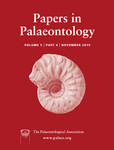Reg. Charity No. 1168330

Tuzoia is a large, bivalved Cambrian arthropod having a widespread distribution in shallow‐shelf to deeper marine Lagerstätten; stratigraphically it ranges from Cambrian Series 2 through the Miaolingian Series. In the present study, three species are recognized from relatively deep‐water deposits of the Balang Formation (Cambrian Stage 4) of Guizhou, South China: Tuzoia sinensis Pan, 1957, T. bispinosa Yuan et Zhao, 1999 and T. lazizhaiensis sp. nov. The new species is unique in having 6–10 small marginal spines on the dorsal margin, an inflated anterior margin with three short, closely spaced marginal spines. These remains, which usually occur as disarticulated valves, are inferred to be parautochthonous. One new specimen of T. lazizhaiensis shows a stalked eye and antenna. New Tuzoia material from the Kaili Biota (Cambrian: Wuliuan Stage) of Guizhou, and from the Guanshan Biota (Cambrian Stage 4) of Yunnan, China, provide additional comparative information about the genus. Some new specimens of T. bispinosa from the Kaili Biota provide information on valve morphology and palaeoecology. One specimen of T. sinensis from the Guanshan Biota provides information on the appendages, and one specimen of T. tylodesa, from the Guanshan Biota adds provides information on the trunk and appendages.